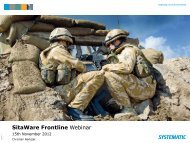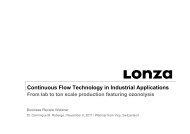Principles of IWEX imaging - Business Review Webinars
Principles of IWEX imaging - Business Review Webinars
Principles of IWEX imaging - Business Review Webinars
- No tags were found...
Create successful ePaper yourself
Turn your PDF publications into a flip-book with our unique Google optimized e-Paper software.
<strong>IWEX</strong>Imaging <strong>of</strong> defects in weldsPrepared by:Date: 5-6-2013Niels Pörtzgen PhD. MSc. MBA
ContentIntroduction<strong>Principles</strong> <strong>of</strong> <strong>IWEX</strong> <strong>imaging</strong>Development <strong>of</strong> the <strong>IWEX</strong> systemSome results from trials<strong>IWEX</strong> compared to current practices (ToFD, sectorial scan)LimitationsConclusions| 2
ContentIntroduction<strong>Principles</strong> <strong>of</strong> <strong>IWEX</strong> <strong>imaging</strong>Development <strong>of</strong> the <strong>IWEX</strong> systemSome results from trials<strong>IWEX</strong> compared to current practices (ToFD, sectorial scan)LimitationsConclusions| 3
IntroductionCurrent inspection philosophy with ultrasonic waves:Detection based on reflection / diffractionDetection based on directional ultrasonic beamsSizing based on amplitudes requires calibration procedureSizing based on diffraction requires presence <strong>of</strong> diffractionsignals| 4
Introduction| 5
Automated Ultrasonic TestingZone discriminationSupplemented by ToFD, transverse, creepEach zone inspected with dedicated probe set-up mountedin scanner a frametandem configuration| 6
Interpretation <strong>of</strong> AUT resultsInterpretation <strong>of</strong> strip charts requires experience and skill
Challenges AUTDetection and sizing dependent on defect shape andorientation limited accuracyDetection and sizing are influenced by horizontal andvertical displacement small practical tolerancesInterpretation <strong>of</strong> strip charts requires experience andskill ambiguous and less reproducible results| 8
Objectives <strong>of</strong> ultrasonic <strong>imaging</strong>Detection independent on defect shape and orientationGenerate an image from defects in (girth) welds whereorientation, position and size <strong>of</strong> a defect are presentStraightforward and unambiguous result displayReliable detection and accurate sizing with practicaltolerances
Poll question #1Is there a need for a new advanced inspectionmethodology?A. No, all the existing methods can cover my inspectionneedsB. Not at the moment, but I am interested in newtechnologiesC. Yes, existing methods are good but have practicallimitationsD. Yes, existing methods are not accurate and reliableenoughE. None <strong>of</strong> the above| 10
ContentIntroduction<strong>Principles</strong> <strong>of</strong> <strong>IWEX</strong> <strong>imaging</strong>Development <strong>of</strong> the <strong>IWEX</strong> systemSome results from trials<strong>IWEX</strong> compared to current practices (ToFD, sectorial scan)LimitationsConclusions| 11
Seismic <strong>imaging</strong>Imaging approach similar to seismic <strong>imaging</strong>With ultrasonic array technology downscaled seismicexperimentCourtesy: H. Spijkerman (NAM)| 12
<strong>Principles</strong> <strong>of</strong> <strong>IWEX</strong> <strong>imaging</strong>| 14
<strong>Principles</strong> <strong>of</strong> <strong>IWEX</strong> <strong>imaging</strong>| 15
The <strong>IWEX</strong> <strong>imaging</strong> processImaging area consist out <strong>of</strong> pixelsBack propagate wave field to each pixel Inverse Wave fieldEXtrapolationThe value <strong>of</strong> the pixel is the amplitude from the backpropagated wave fieldtx| 16
<strong>IWEX</strong> on a machined ‘defect’defect image, location andorientation remain2 mm length @ 45°| 17
Use back wall as ‘mirror’Notch 2 mm 45°direct pathback wall reflection| 18
Use <strong>of</strong> multiple insonification pathsThe <strong>IWEX</strong> ‘modes’ using different sound paths<strong>IWEX</strong> modes can be color coded, applied on envelope| 19
ContentIntroduction<strong>Principles</strong> <strong>of</strong> <strong>IWEX</strong> <strong>imaging</strong>Development <strong>of</strong> the <strong>IWEX</strong> systemSome results from trials<strong>IWEX</strong> compared to current practices (ToFD, sectorial scan)LimitationsConclusions| 20
Development <strong>of</strong> the <strong>IWEX</strong> systemMaturityRelease Rotoscan <strong>IWEX</strong> 3DHW scan speed & SW improvementRelease <strong>IWEX</strong> 3D ImagerInvention Multi-mode <strong>IWEX</strong>Release demo systemDevelopment <strong>IWEX</strong> HWStart researchRelease research system20032008 201120122013| 21
ContentIntroduction<strong>Principles</strong> <strong>of</strong> <strong>IWEX</strong> <strong>imaging</strong>Development <strong>of</strong> the <strong>IWEX</strong> systemSome results from trials<strong>IWEX</strong> compared to current practices (ToFD, sectorial scan)LimitationsConclusions| 22
Results from various machined defectsCDE1E2G<strong>IWEX</strong> - 0 <strong>IWEX</strong> - 2 <strong>IWEX</strong> – 1 & 3| 23
Large diameter (in a workshop)| 24
Results from actual weldsWall thickness 15,8 mmEnvelope and color coded modes| 25
Results from actual weldsWall thickness 15,8 mmremaining ligament| 26
Results from actual weldsWall thickness 7,9 mm4 MHz probe characteristics not optimal| 27
Results from actual weldsWall thickness 12,7 mm‘Doubling’ indicationHigh-low| 28
Small diameter (6.625“, in a workshop)| 29
Defect and high –lowhigh-lowAll <strong>IWEX</strong> modes‘Cross mode’ removed| 30
Cracks in seam welds| 31
Cracks in seam welds (6.5 mm)| 32
First field trial May 2013 (48”)| 33
<strong>IWEX</strong> 3D| 34
ContentIntroduction<strong>Principles</strong> <strong>of</strong> <strong>IWEX</strong> <strong>imaging</strong>Development <strong>of</strong> the <strong>IWEX</strong> systemSome results from trials<strong>IWEX</strong> compared to current practices (ToFD, sectorial scan)LimitationsConclusions| 35
Comparison with other methodsToFDPulseEchoPAsectorial<strong>IWEX</strong>Dependency defect orientation low high moderate lowDependency location low high low lowResolution (i.e. stacked defects) high low moderate highSet –up time (calibration) short moderate moderate shortInspection speed high high High moderateData visualization C -scan A-B-C-D S-scan imageSizing diffraction amplitude diffr. ampl. meshAccuracy high low moderate highProbability <strong>of</strong> detection high low high highNote that this table is qualitative and may be subjectiveA thorough quantitative comparison has not yet been performed| 36
Comparison with other methodsOrientation dependencySectorial scan| 37
Poll question #2What would be your requirement for a new inspectionmethodology?A. A statistical comparison with existing methods, supervisedby a third partyB. An evaluation fit for purpose with your dedicated programC. A qualification based on existing codes witnessed by athird partyD. Other| 38
ContentIntroduction<strong>Principles</strong> <strong>of</strong> <strong>IWEX</strong> <strong>imaging</strong>Development <strong>of</strong> the <strong>IWEX</strong> systemSome results from trials<strong>IWEX</strong> compared to current practices (ToFD, sectorial scan)LimitationsConclusions| 39
LimitationsHigh – low creates a ‘double’ back wall in the imageLikewise, wall thickness variations cause a double back wallUn-sharpness due to limited aperture (image or imagination?)| 40
LimitationsSurface breaking defects cause corner trap signals (can beremoved)| 41
ContentIntroduction<strong>Principles</strong> <strong>of</strong> <strong>IWEX</strong> <strong>imaging</strong>Development <strong>of</strong> the <strong>IWEX</strong> systemSome results from trials<strong>IWEX</strong> compared to current practices (ToFD, sectorial scan)LimitationsConclusions| 42
ConclusionUltrasonic array technology is used to measure wave fieldsImages can be constructed to visualize defects in 2D and3D view using Inverse Wave field EXtrapolationOther applications possible (austenitic weld inspection,coating inspection)Future goal a quantitative evaluation and comparisonSome advantages <strong>of</strong> the <strong>IWEX</strong> methodology are:• Straightforward interpretation• Less depend on the operator skills• Less depend on calibration reflectors;• Reliable detection and accurate sizing;• <strong>IWEX</strong> image is directly linked to defect propertiesVideo clip from field test| 43
Field test May 2013| 44
Thank you for your attention!Contact information:Niels Pörtzgenniels.portzgen@applusrtd.com+31624670312
















